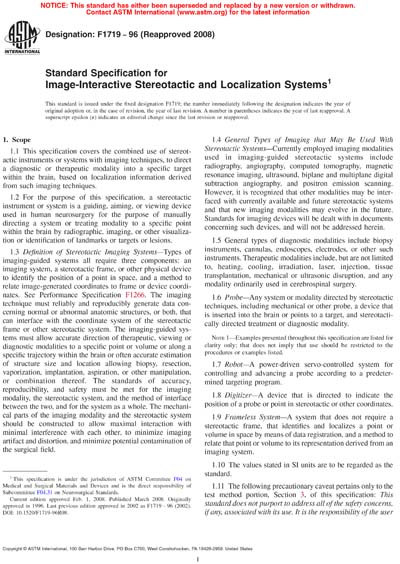Historical
ASTM F1719-96(2008)
Standard Specification for Image-Interactive Stereotactic and Localization Systems
1.1 This specification covers the combined use of stereotactic instruments or systems with imaging techniques, to direct a diagnostic or therapeutic modality into a specific target within the brain, based on localization information derived from such imaging techniques.
1.2 For the purpose of this specification, a stereotactic instrument or system is a guiding, aiming, or viewing device used in human neurosurgery for the purpose of manually directing a system or treating modality to a specific point within the brain by radiographic, imaging, or other visualization or identification of landmarks or targets or lesions.
1.3 Definition of Stereotactic Imaging Systems—Types of imaging-guided systems all require three components: an imaging system, a stereotactic frame, or other physical device to identify the position of a point in space, and a method to relate image-generated coordinates to frame or device coordinates. See Performance Specification F 1266
1.4 General Types of Imaging that May Be Used With Stereotactic Systems—Currently employed imaging modalities used in imaging-guided stereotactic systems include radiography, angiography, computed tomography, magnetic resonance imaging, ultrasound, biplane and multiplane digital subtraction angiography, and positron emission scanning. However, it is recognized that other modalities may be interfaced with currently available and future stereotactic systems and that new imaging modalities may evolve in the future. Standards for imaging devices will be dealt with in documents concerning such devices, and will not be addressed herein.
1.5 General types of diagnostic modalities include biopsy instruments, cannulas, endoscopes, electrodes, or other such instruments. Therapeutic modalities include, but are not limited to, heating, cooling, irradiation, laser, injection, tissue transplantation, mechanical or ultrasonic disruption, and any modality ordinarily used in cerebrospinal surgery.
1.6 Probe—Any system or modality directed by stereotactic techniques, including mechanical or other probe, a device that is inserted into the brain or points to a target, and stereotactically directed treatment or diagnostic modality.
Note 1—Examples presented throughout this specification are listed for clarity only; that does not imply that use should be restricted to the procedures or examples listed.
1.7 Robot—A power-driven servo-controlled system for controlling and advancing a probe according to a predetermined targeting program.
1.8 Digitizer—A device that is directed to indicate the position of a probe or point in stereotactic or other coordinates.
1.9 Frameless System—A system that does not require a stereotactic frame, that identifies and localizes a point or volume in space by means of data registration, and a method to relate that point or volume to its representation derived from an imaging system.
1.10 The values stated in SI units are to be regarded as the standard.
1.11 The following precautionary caveat pertains only to the test method portion, Section 3, of this specification: This standard does not purport to address all of the safety concerns, if any, associated with its use. It is the responsibility of the user of this standard to establish appropriate safety and health practices and determine the applicability of regulatory limitations prior to use.
Content Provider
ASTM International [astm]






